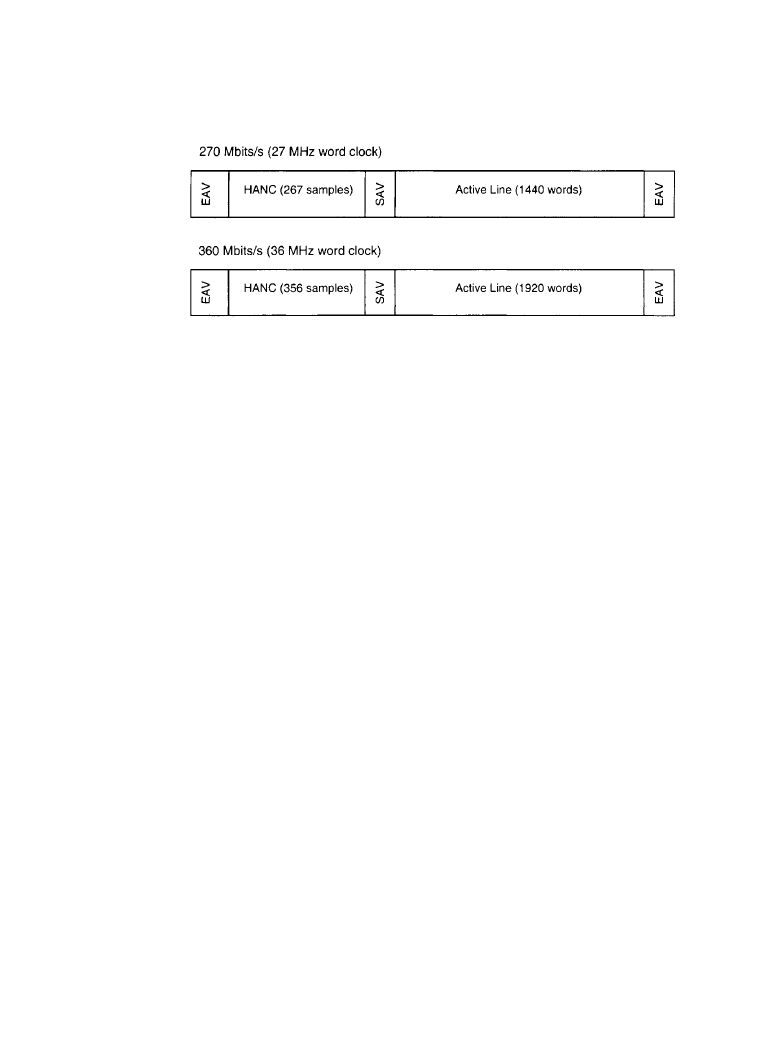ВУЗ: Казахская Национальная Академия Искусств им. Т. Жургенова
Категория: Книга
Дисциплина: Не указана
Добавлен: 03.02.2019
Просмотров: 21731
Скачиваний: 19

8-8 Audio Networking
8.1.2c
Network Layer
Layer 3 of the OSI model guarantees the delivery of transmissions as requested by the upper lay-
ers of the OSI [2]. The network layer establishes the physical path between the two communicat-
ing endpoints through the communications subnet, the common name for the physical, data link,
and network layers taken collectively. As such, layer 3 functions (routing, switching, and network
congestion control) are critical. From the viewpoint of a single LAN, the network layer is not
required. Only one route—the cable—exists. Inter-network connections are a different story,
however, because multiple routes are possible. The Internet Protocol (IP) and Internet Packet
Exchange (IPX) are two examples of layer 3 protocols.
The network layer confirms that signals get to their designated targets, and then translates
logical addresses into physical addresses. The physical address determines where the incoming
transmission is stored. Lost data or similar errors can usually be traced back to the network layer,
in most cases incriminating the network operating system. The network layer is also responsible
for statistical tracking, and communications with other environments, including gateways. Layer
3 decides which route is the best to take, given the needs of the transmission. If router tables are
being corrupted or excessive time is required to route from one network to another, an operating
system error on the network layer may be involved.
8.1.2d
Transport Layer
Layer 4, the transport layer, acts as an interface between the bottom three and the upper three lay-
ers, ensuring that the proper connections are established and maintained [2]. It does the same
work as the network layer, only on a local level. The network operating system driver performs
transport layer tasks.
Connection difficulties between computers on a network can sometimes be attributed to the
shell driver. The transport layer may have the ability to save transmissions that were en route in
the case of a system crash, or re-route a transmission to its destination in case of primary route
failure. The transport layer also monitors transmissions, checking to make sure that packets
arriving at the destination node are consistent with the build specifications given to the sending
node in layer 2. The data-link layer in the sending node builds a series a packets according to
specifications sent down from higher levels, then transmits the packets to a destination node. The
transport layer monitors these packets to ensure they arrive according to specifications indicated
in the original build order. If they do not, the transport layer calls for a retransmission. Some
operating systems refer to this technique as a sequenced packet exchange (SPX) transmission,
meaning that the operating system guarantees delivery of the packet. Transmission control proto-
col (TCP) is the transport layer protocol associated with the IP network layer protocol.
8.1.2e
Session Layer
Layer 5 is responsible for turning communications on and off between communicating parties
[2]. Unlike other levels, the session layer can receive instructions from the application layer
through the network basic input/output operation system (netBIOS), skipping the layer directly
above it. The netBIOS protocol allows applications to “talk” across the network. The session
layer establishes the session, or logical connection, between communicating host processors.
Name-to-address translation is another important function; most communicating processors are
known by a common name, rather than a numerical address.
Downloaded from Digital Engineering Library @ McGraw-Hill (www.digitalengineeringlibrary.com)
Copyright © 2004 The McGraw-Hill Companies. All rights reserved.
Any use is subject to the Terms of Use as given at the website.
Network Concepts

Network Concepts 8-9
Multi-vendor problems often crop up in the session layer. Failures relating to gateway access
usually fall into layer 5 for the OSI model, and are typically related to compatibility issues.
8.1.2f
Presentation Layer
Layer 6 translates application layer commands into syntax understood throughout the network
[2]. It also translates incoming transmissions for layer 7. The presentation layer masks other
devices and software functions. Layer 6 software controls printers and other peripherals, and may
handle encryption and special file formatting. Data compression, encryption, and translations are
examples of presentation layer functions.
Failures in the presentation layer are often the result of products that are not compatible with
the operating system, an interface card, a resident protocol, or another application.
8.1.2g
Application Layer
At the top of the seven-layer stack is the application layer. It is responsible for providing proto-
cols that facilitate user applications [2]. Print spooling, file sharing, and e-mail are components
of the application layer, which translates local application requests into network application
requests. Layer 7 provides the first layer of communications into other open systems on the net-
work.
Failures at the application layer usually center around software quality and compatibility
issues. The program for a complex network may include latent faults that will manifest only
when a given set of conditions are present. The compatibility of the network software with other
programs is another source of potential problems.
8.1.3
Network Classifications
Although there are no hard and fast rules for network categorization, some general parameters
are usually accepted for most applications. The following are a few of the more common catego-
ries of networking [1]:
•
Remote connectivity: A single remote user wishes to access local network resources. This
type of networking is particularly important to mobile professionals such as sales representa-
tives, service technicians, field auditors, and so on.
•
Local area networking: Multiple users’ computers are interconnecting for the purpose of
sharing applications, data, or networked technology such as printers or mass storage. Local
area networks (LANs) can have anywhere from two or three users to several hundred (or
more). LANs are often limited to a single department or floor in a building, although techni-
cally any single-location corporation could be networked via a LAN.
•
Internetworking: Also known as LAN-to-LAN networking or connectivity, internetworking
involves the connection of multiple LANs and is common in corporations in which users on
individual departmental LANs need to share data or otherwise communicate. The challenge
of internetworking is in getting departmental LANs of different protocol stacks (as deter-
mined by use of the OSI model) to talk to each other, while only allowing authorized users
Downloaded from Digital Engineering Library @ McGraw-Hill (www.digitalengineeringlibrary.com)
Copyright © 2004 The McGraw-Hill Companies. All rights reserved.
Any use is subject to the Terms of Use as given at the website.
Network Concepts

8-10 Audio Networking
access to the internetwork and other LANs. Variations of internetworking also deal with con-
necting LANs to mainframes or minicomputers rather than to other LANs.
•
Wide area networking: Also known as enterprise networking, involves the connection of
computers, network nodes, or LANs over a sufficient distance as to require the purchase of
wide area network (WAN) service from the local phone company or an alternative carrier. In
some cases, the wide area portion of the network may be owned and operated by the corpora-
tion itself. Nonetheless, the geographic distance between nodes is the determining factor in
categorizing a wide area network. A subset of WANs, known as metropolitan area networks
(MANs), are confined to a campus or metropolitan area of usually not more than a few miles
in diameter.
The important thing to remember is that categorization of networking is somewhat arbitrary
and that what really matters is that the proper networking technology (hardware and software) is
specified in any given system in order to meet stated business objectives.
8.1.4
References
1.
Goldman, James E.: “Network Communication,” in The Electronics Handbook, Jerry C.
Whitaker (ed.), CRC Press, Boca Raton, Fla., 1996.
2.
Dahlgren, Michael W.: “Servicing Local Area Networks,” Broadcast Engineering, Intertec
Publishing, Overland Park, Kan., November 1989.
8.1.5
Bibliography
Goldman, J: Applied Data Communications: A Business Oriented Approach, 2nd ed., Wiley,
New York, N.Y., 1998.
Goldman, J: Local Area Networks: A Business Oriented Approach, 2nd ed., Wiley, New York,
N.Y., 2000.
Held, G.: Ethernet Networks: Design Implementation, Operation and Management, Wiley, New
York, N.Y., 1994.
Held, G.: Internetworking LANs and WANs, Wiley, New York, N.Y., 1993.
Held, G.: Local Area Network Performance Issues and Answers, Wiley, New York, N.Y., 1994.
Held, G.: The Complete Modem Reference, Wiley, New York, N.Y., 1994.
International Organization for Standardization: “Information Processing Systems—Open Sys-
tems Interconnection—Basic Reference Model,” ISO 7498, 1984.
Miller, Mark A.: LAN Troubleshooting Handbook, M&T Books, Redwood City, Calif., 1990.
Miller, Mark A.: “Servicing Local Area Networks,” Microservice Management, Intertec Publish-
ing, Overland Park, Kan., February 1990.
Downloaded from Digital Engineering Library @ McGraw-Hill (www.digitalengineeringlibrary.com)
Copyright © 2004 The McGraw-Hill Companies. All rights reserved.
Any use is subject to the Terms of Use as given at the website.
Network Concepts

8-11
Chapter
8.2
Serial Digital Video/Audio Systems
Jerry C. Whitaker, Editor-in-Chief
8.2.1
Introduction
Parallel connection of digital video equipment is practical only for relatively small installations.
There is, then, a clear need to transmit data over a single coaxial or fiber line [1]. To reliably
move large amounts of data from one location to another, it is necessary to modify the serial sig-
nal prior to transmission to ensure that there are sufficient edges (data transitions) for reliable
clock recovery, to minimize the low frequency content of the transmitted signal, and to spread
the transmitted energy spectrum so that radio frequency emission problems are minimized.
In the early 1980s, a serial interface for Rec. 601 signals was recommended by the EBU. This
interface used 8/9 block coding and resulted in a bit rate of 243 Mbits/s. The interface did not
support ten-bit precision signals, and there were some difficulties in producing reliable, cost
effective integrated circuits for the protocol. The block coding-based interface was abandoned
and replaced by an interface with a channel coding scheme that utilized scrambling and conver-
sion to NRZI (non return to zero inverted). This serial interface was standardized as SMPTE
259M and EBU Tech. 3267, and is defined for both component and composite conventional
video signals, including embedded digital audio.
8.2.2
Serial Digital Interface
Conceptually, the serial digital interface is much like a carrier system for studio applications.
Baseband audio and video signals are digitized and combined on the serial digital “carrier.” (SDI
is not strictly a carrier system in that it is a baseband digital signal, not a signal modulated on a
carrier wave.) The bit rate (carrier frequency) is determined by the clock rate of the digital data:
143 Mbits/s for NTSC, 177 Mbits/s for PAL, and 270 Mbits/s for Rec. 601 component digital.
The widescreen (16
× 9) component system defined in SMPTE 267 will produce a bit rate of
360 Mbits/s. This serial interface may be used with normal video coaxial cable or fiber optic
cable, with the appropriate interface adapters.
Following serialization of the video information, the data stream is scrambled by a mathemat-
ical algorithm and then encoded. At the receiver, an inverse algorithm is used in the deserializer
to recover the data. In the serial digital transmission system, the clock is contained in the data, as
Source: Standard Handbook of Audio and Radio Engineering
Downloaded from Digital Engineering Library @ McGraw-Hill (www.digitalengineeringlibrary.com)
Copyright © 2004 The McGraw-Hill Companies. All rights reserved.
Any use is subject to the Terms of Use as given at the website.

8-12 Audio Networking
opposed to the parallel system where there is a separate clock line. By scrambling the data, an
abundance of transitions is assured, which is required for reliable clock recovery.
Figure 8.2.1 shows the SDI bitstream for 270 Mbits/s and 360 Mbits/s operation. The EAV
and SAV elements of the bitstream are reserved word sequences that indicate the start and end of
a video line, respectively. For the 270 Mbits/s case, each line contains 1440 10 bit 4:2:2 video
samples. The horizontal interval (HANC, horizontal ancillary data) contains ancillary data,
error detection and control, embedded audio, and other information. Vertical ancillary data
(VANC) also can be used.
8.2.2a
Embedded Audio
One of the important features of the serial digital video interface is the facility to embed (multi-
plex) several channels of AES/EBU digital audio in the video bitstream. SDI with embedded
audio is particularly helpful in large systems where a strict link between the video and its associ-
ated audio is an important feature. In smaller systems, such as a post-production suite, it is gen-
erally preferable to maintain a separate audio path.
SMPTE 272M defines the mapping of digital audio data, auxiliary data, and associated con-
trol information into the ancillary data space of the serial digital video format. Several modes of
operation are defined and letter suffixes are used to help identify interoperability between equip-
ment with differing capabilities. These descriptions are given in Table 8.2.1. (Note that modes B
through J shown in the table require a special audio control packet.)
Some examples will help explain how Table 8.2.1 is used. A transmitter that can only accept
20 bit 48 kHz synchronous audio is said to conform to SMPTE 272M-A. A transmitter that sup-
ports 20 bit and 24 bit 48 kHz synchronous audio conforms to SMPTE 272M-ABC. A receiver
that only uses the 20 bit data but can accept the level B sample distribution would conform to
SMPTE 272M-AB because it can handle either sample distribution.
Figure 8.2.1
The basic SDI bitstream.
Downloaded from Digital Engineering Library @ McGraw-Hill (www.digitalengineeringlibrary.com)
Copyright © 2004 The McGraw-Hill Companies. All rights reserved.
Any use is subject to the Terms of Use as given at the website.
Serial Digital Video/Audio Systems